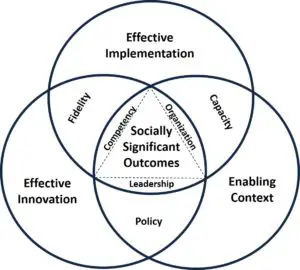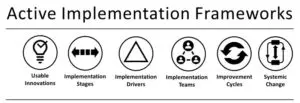Scaling is essential to realizing socially significant benefits in human services. Scaling effective innovations requires scaling effective implementation supports.
To accomplish the goals of scaling, systems must change to enable the development of implementation capacity to assure benefits for whole populations (Figure 1). The quality of the innovation as delivered in practice (fidelity) relies on purposeful use of effective implementation methods. Policies that enable scaling are the product of timely and relevant communication relating outcomes to innovation fidelity and implementation capacity.
Scaled use of an effective innovation depends on expanded implementation capacity to support, sustain, and improve high quality replications of the innovation. Innovations cannot produce socially significant outcomes unless they are used as intended (with fidelity) in practice with individuals in the population of intended beneficiaries. In the absence of relevant feedback regarding fidelity and outcomes, policy development and revision lacks the focus for scaling.
The Active Implementation Frameworks are used to purposefully and effectively scale effective implementation supports for effective innovations in enabling system contexts.
The logic of scaling
By itself, knowing the number of individuals, organizations, or systems that are attempting to use an innovation means little as a scaling metric. The denominator and the quality of the numerator each need to be operationalized to determine the extent to which scaling is achieved for the intended population. The denominator is the entire population of interest (e.g. all children from birth to age 5). The numerator is the number of those in the population who are receiving effective services (e.g. high fidelity; intended outcomes). Social significance is approached when the scaling ratio (numerator divided by the denominator) exceeds 60%.
Some basics of scaling are:
- The goal of scaling is to reach the entire population
- Entire populations cannot be reached all at once
- Transformation Zones are required to establish the first examples of scaling
- Usability improvement cycles are based on examined experience and data so that constant adjustments are made to reach the goals
- Scaling innovations requires first scaling implementation capacity
- An implementation infrastructure is established in the form of linked Implementation Teams
- Implementation capacity to create more implementation capacity is initiated so that practitioners receive effective support for using multiple innovations
- Alignment, integration, and leveraging of existing structures, roles, and functions are focused on improving outcomes effective and efficient use of resources
- Scaling requires Systemic Change
- Exploration Stage informed-agreements are required to initiate and manage change processes to achieve goals at a provincial, state, or national level
- Practice-policy communication loops (constant adjustment based on recursive feedback) are used by engaged leaders
- Top down support for bottom up change in practices and outcomes
- Scaling requires relevant and regular action assessments
- Frequent assessments of implementation capacity functions are used to monitor progress (implementation fidelity)
- Frequent assessments of fidelity at the practice level are used to monitor implementation outcomes (intervention fidelity)
- Action planning based on data is required to meet, exceed, and expand implementation capacity resources
Ethical and moral considerations
Ethical and moral considerations arise in the context of scaling. Realizing the benefits of effective innovations supported by effective implementation and enabling contexts is the goal of scaling. Yet, realizing benefits of innovations at scale cannot be achieved all at once in any system. Scaling begins in a Transformation Zone and expands to the entire system over a period of years. Thus, for a time, until the whole population is reached, scaling creates disparity – some people are advantaged, and others are not (yet). Those who are planning scaling efforts need to be cautious that existing inequalities are not exacerbated in the process of scaling. It is tempting to go where we are most wanted and not where we are most needed. The tree with low hanging fruit may not be the morally appropriate tree to choose when existing inequalities are considered.
With respect to the ethical and moral issues regarding creating disparity when working in a Transformation Zone, highest needs individuals, groups, organizations, or countries are over selected for inclusion in the Transformation Zone. Thus, while it still is necessary to use typical Exploration Stage activities to guide the selection process, more of the highest needs groups are included in the pool of possibles. In Transformation Zones configured in this way, scaling begins where change is most needed while working with organizations and systems that are ready, willing, and able to engage in the change processes that enable scaling to be successful.
Download: Eradicating smallpox – Implementation
Download: System Change in Education


